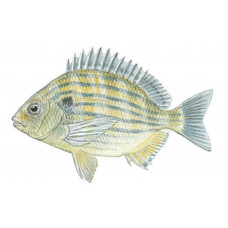Latin name
Archosargus rhomboidalis
Other names
Seabream, brim, tropical sheepshead, chopa amarilla, or salema.
Identification
The West Atlantic sea bream is similar to other members of its genus. It differs in that it is smaller, has several horizontal blue stripes mixed with gold or yellow and a dark spot on the shoulder. It has vertical bars like Sheepshead, but these disappear with age. The West Atlantic sea bream has nine spines on its dorsal fins and 10-11 soft rays. They have only three spines on their anal fins, but the same number of rays. The colon makes up 90% of the length of the entire digestive tract. Males and females can be distinguished by the color of their pelvic fins: in males the fin is partially or completely dark and in females it is orange.
Distribution
The sea bream (Archosargus rhomboidalis) lives in the western Atlantic Ocean from the northeastern Gulf of Mexico to Argentina, including the Caribbean and the West Indies.
Habitat
Some sea bream species are found in estuaries; some are found in deeper, shelf waters. Some ascend into brackish but not fresh water. In estuarine environments, bream often visit seagrass beds, underwater reefs and rocks, and bridge abutments where mussels and oysters grow.
Size
The maximum published length of sea bream in the West Atlantic is 13 inches, although they usually grow to about 7.9 inches. The heaviest one weighed 1.2 pounds.
Life history and Behavior
No information
Food and feeding habits
The bream is mostly omnivorous and eats crustaceans, crayfish, mollusks including oysters and mussels, small fish, worms, algae. Some also eat bread, chicken entrails, mullet entrails, cheese, meat used as bait.
Reproduction
No information
| Classification | |
| Phylum | Chordata |
| Class | Actinopterygii |
| Squad | Perciformes |
| Family | Sparidae |
| Genus | Archosargus |
| Species | A. rhomboidalis |
| Features | |
| Conservation status | Least Concern |
| Habitat | Pelagic |
| Life span, years | 2 |
| Maximum body weight, kg | 0.55 |
| Maximum length, cm | 33 |
| Sailing speed, m/s | No information |
| Threat to people | Edible |
| Way of eating | Omnivore |



